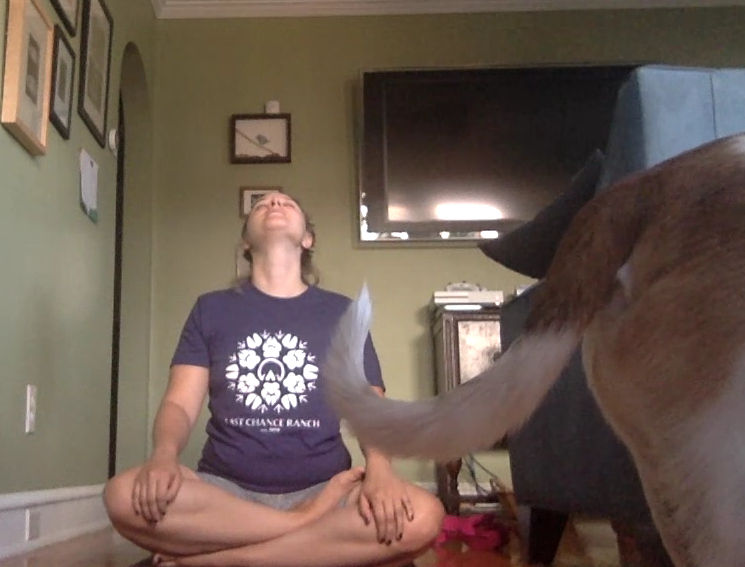Where Are You?
- Samantha William

- Sep 21
- 4 min read

When I'm helping someone in an asana I never care how close they get towards the end of their range of motion, in other words how physically deep they go into a posture. In fact, usually I'm cringing at how deep they are trying to go. I can see their potential outcome based on setup. It’s not uncommon for me to have someone stop moving about a millimeter towards range because I see weird rotations that will cause a traffic jam later and ultimately limit range and/or cause injury. Understanding the approach to an asana is key to moving towards executing it safely, not by how far we can push into it. Without this understanding the end result is usually wonky, to say the least.
What can also happen is the set up is good but then somewhere along the way something rotates out of place and we miss our mark. Then we try to correct once we’re there, but it’s too late because we can’t safely adjust rotations if we are stretched to the max. Then the tendency is to push deeper, YIKES! That’s not going to work out well long term, possibly even short term. Rotations are more important than getting to the end of our range of motion.
One of the most important parts to accessing any asana is understanding rotations. Understanding where our joints are in any given position is what will make an asana safe, productive and efficient. Going deeply into a posture with confused rotations is very problematic which can and will cause injury and stagnation. Getting longer in an asana doesn't mean taking it deeper. We want to extend our lines, not necessarily move the lines closer together.
It’s difficult and unsafe to try and correct rotations when we’re stretched to the end of our alleged range. It’s key to maintain correct rotations when moving towards true range. It’s not true range if the execution or anywhere along the way is compromising the intention of the asana.
It can be tricky to know when our rotations make us wonky in an asana for a few reasons. Here are two that come to the front of my mind.
We think we know where we are. Most times this happens subconsciously. We’re used to how we use our body so our compass is skewed. It’s helpful to get an outside perspective of your practice. Having someone watch you move to make sure you're not doing anything weird habitually is the path to progressing and avoiding injury.
We feel a sensation and lean into it. Not all sensation is wanted or needed.
Sometimes a sensation is telling us we are in the wrong place for the position we are trying to achieve. For example to feel pulling in the low back when we forward fold is not typically what we are going for. Leaning into that sensation is most likely not a good idea but it depends on the person's anatomy.
When rotations are out of position the muscle engagement typically doesn’t compliment the movement and ultimately the position the body is moving towards. Injury and/or stagnation tends to present itself instead of receiving the benefits of the asana and progressing. It’s a good idea to practice far from range, make sure everything stays in place there and then incrementally, over time, go deeper into it with correct muscular support.
I love discovering ways to practice all 8 limbs of yoga during my asana practice. After all asana is special because it is how we translate all of the other limbs. Exploring rotations is a way we practice the Yamas limb 1, Niyamas limb 2, Pratyahara limb 5, Dhrana limb 6. We are a pile of patterns. Yoga combs through our patterns and is a tool to get organized mentally and physically. We have to show up and tune in regularly to comb through these patterns.
One of the many great things about Ashtanga is that it’s a set sequence that is designed to be practiced almost daily. It’s set so we know where we are within the guidelines. Knowing the sequence frees our mind so we can focus on breathing and scanning through our tendencies rather than thinking about what pose comes next.
As you are setting up your asana ask yourself:
Where am I starting from?
The word neutral will be in your answer.
Are my joints positioned in a way that supports the asana?
Joints should be aligned based on direction of movement and muscular/skeletal limitations.
On the way make stops to check your rotations and stay diligent about your alignment. Stop at your true range, which might be surprisingly not as deep and probably more physically challenging to maintain than you're used to. This can be humbling... But it's always worth embracing the challenge.
Once you get to your true range ask yourself:
How can I maintain my structure?
Scan the asana for laziness, joints tend to collapse. Maintaining functional support around the joints is a must for a long term practice.
What is the point of being here?
My generic mental response is "To make my weakness my strengths". There are an unlimited amount of answers.
I highly recommend seeing how the practice feels staying far back away from your range and focus on rotations and length rather than moving deeper into an asana. Use this as a way to practice the other limbs along the way.
Keep practicing yogi’s
Samantha




Comments